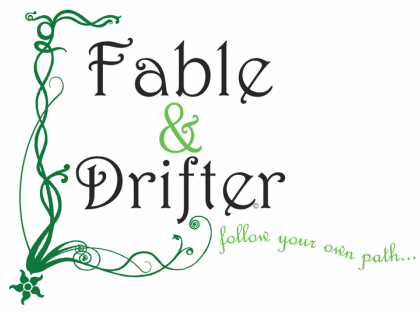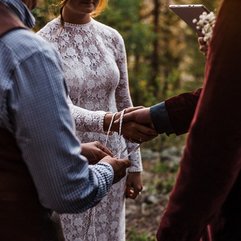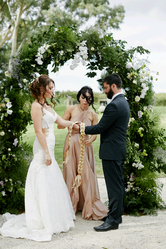What is a handfasting cord?
A handfasting cord (sometimes known as a handbinding cord or simply a wedding cord) is a cord or ribbon which is used for literally ‘tying the knot’ during a wedding or betrothal ceremony. The couple stand together and the handfasting cord is wrapped or tied around their joined hands, representing the joining of their lives and the binding of their union. Through this ritual, the couple display their unity and become bound to one another.
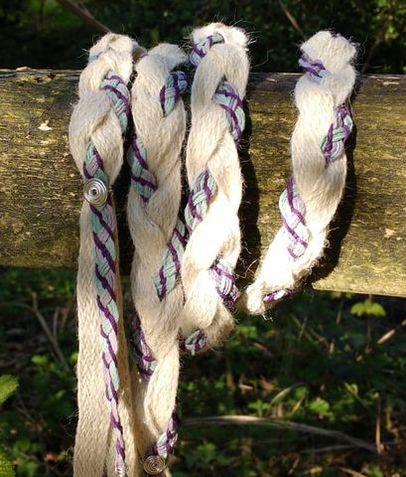 'Celtic thistle' eco hemp and jute handfasting cord by Fable & Drifter
'Celtic thistle' eco hemp and jute handfasting cord by Fable & Drifter
The history of handfasting
The tradition of handfasting is very old, and is believed to have originated in pre-Christian Celtic Europe. Original Celtic handfasting ceremonies would have been undertaken outdoors and the custom was closely associated with nature, reflecting the Celtic and Druidic reverence for the natural world.
It is sometimes said that handfasting was originally used to begin a ‘trial’ marriage or engagement, lasting one year and one day, after which the couple would marry or part. This view is now thought to be myth, and it seems that handfasting ceremonies have always been used to signify a lasting betrothal.
Handfasting has been rediscovered in recent times, and began to be incorporated into pagan and Wiccan ceremonies and alternative weddings from the 1960s onwards.
Since around the turn of the millennium, this expressive and deeply meaningful ancient tradition has become a popular element of many weddings, both alternative and mainstream. As a non-religious custom, handfasting is complementary to almost any type of ceremony and there are now many officiants and celebrants who are experienced in performing handfasting ceremonies and who can guide you through the process of planning and experiencing your own handfasting.
The handfasting ceremony
In weddings and ceremonies which involve a handfasting, it is often the handfasting element of the day that is the main focus, alongside the exchange of rings. Couples usually exchange vows just before, during or just after the handfasting. During the ceremony, the officiant or celebrant will explain the ritual and what it means to the couple, before inviting the couple to join hands, symbolising their free will to enter into the union. The handfasting cord is then wrapped around their hands and knotted.
The significance of the knotted cord
Once completed, the handfasting knot represents the oneness of the couple. In pagan and Wiccan traditions, the wrapped cord forms an infinity symbol to signify their lasting union, but there are many different ways in which the cord may be tied.
After the wedding or ceremony, most couples choose to keep their knotted handfasting cord as a symbol of their commitment to each other and their togetherness, often using the same cord again during anniversary celebrations and if renewing their vows. Some couples choose to display their knotted cord in a frame, and some people believe that the presence of the cord brings blessings to a couple’s home.
The tradition of handfasting is very old, and is believed to have originated in pre-Christian Celtic Europe. Original Celtic handfasting ceremonies would have been undertaken outdoors and the custom was closely associated with nature, reflecting the Celtic and Druidic reverence for the natural world.
It is sometimes said that handfasting was originally used to begin a ‘trial’ marriage or engagement, lasting one year and one day, after which the couple would marry or part. This view is now thought to be myth, and it seems that handfasting ceremonies have always been used to signify a lasting betrothal.
Handfasting has been rediscovered in recent times, and began to be incorporated into pagan and Wiccan ceremonies and alternative weddings from the 1960s onwards.
Since around the turn of the millennium, this expressive and deeply meaningful ancient tradition has become a popular element of many weddings, both alternative and mainstream. As a non-religious custom, handfasting is complementary to almost any type of ceremony and there are now many officiants and celebrants who are experienced in performing handfasting ceremonies and who can guide you through the process of planning and experiencing your own handfasting.
The handfasting ceremony
In weddings and ceremonies which involve a handfasting, it is often the handfasting element of the day that is the main focus, alongside the exchange of rings. Couples usually exchange vows just before, during or just after the handfasting. During the ceremony, the officiant or celebrant will explain the ritual and what it means to the couple, before inviting the couple to join hands, symbolising their free will to enter into the union. The handfasting cord is then wrapped around their hands and knotted.
The significance of the knotted cord
Once completed, the handfasting knot represents the oneness of the couple. In pagan and Wiccan traditions, the wrapped cord forms an infinity symbol to signify their lasting union, but there are many different ways in which the cord may be tied.
After the wedding or ceremony, most couples choose to keep their knotted handfasting cord as a symbol of their commitment to each other and their togetherness, often using the same cord again during anniversary celebrations and if renewing their vows. Some couples choose to display their knotted cord in a frame, and some people believe that the presence of the cord brings blessings to a couple’s home.
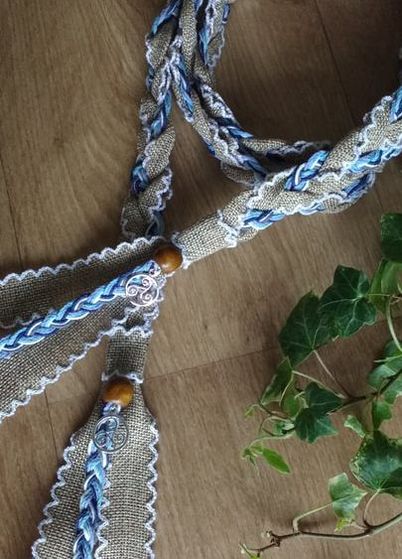 'Spirit of the sky' rustic handfasting cord with silver Triskeles
by Fable & Drifter
'Spirit of the sky' rustic handfasting cord with silver Triskeles
by Fable & Drifter
Choosing a handfasting cord
Given the significance attached to the knotted handfasting cord, it’s important to choose one that has meaning for you and your partner. There's a wide range of handfasting cords available, so what should you think about when choosing?
Length and width – before choosing a handfasting cord, it can be helpful to talk with your celebrant or officiant about how they will bind or knot the cord, as they may have particular size requirements for this. Most celebrants will be able to accommodate a range of different cord sizes however, so think about whether you prefer the look of a longer or a shorter cord, a dainty, narrow one or one that is wider and more substantial.
Style - do you want a contemporary looking cord, or one with more of a timeless quality to it? Remember that your handfasting cord will be a part of your life for many years to come, so it can be a good idea to think about how tastes and fashions may change with time. If you plan to display the knotted cord in your home, think about how the cord will look in that setting, as well as when it's in use on the day of your ceremony and in your wedding photographs.
Colour – do you want a neutral cord, say in white, cream, natural or earth tones, or do you want to include some colour? You may decide you want to include colours that are meaningful to you as a couple, or colours which match the theme and flowers for your ceremony. Some couples choose colours which they feel symbolise something significant for them, such as green and earth tones to symbolise nature, or blue for the sea or sky.
Materials – it's helpful to discuss together whether you’re drawn to synthetic fibres, which tend to have a glossy sheen to them and give a contemporary look to the cord, or whether you prefer natural materials, as used in traditional handfasting cords. Natural fibres can be used to give a timeless, rustic, traditional or folk appearance to your handfasting cord, and natural materials such as silk, cotton and hemp can be used to create a smooth and soft finish. Environmentally conscious couples may prefer to choose natural fibres in their handfasting cord as a way of connecting with their deeper values on the day of their marriage.
Design – many handfasting cords are braided / plaited or woven, as this symbolises the inter-twining of the couples lives, hearts and souls, as well as providing a traditional 'Celtic' look to the cord. I always think that Celtic style braids are particularly appropriate, as they are considered endless paths woven together, and they represent eternity in love, loyalty and companionship, making handfasting cords containing Celtic braids an expressive and meaningful symbol with which to bind yourselves to one another. Alternatively, some couples choose to keep it simple and use a single ribbon (of natural or other material), or a number of ribbons and cords together for their ceremony.
Additional embellishments – handfasting cords are available with a wide range of embellishments, including charms, pendants, beads, crystals, chains, gemstones, artificial flowers, feathers… you name it! If you're buying a handfasting cord from a maker who can customise your order, they may be able to accommodate specific requests for particular additions that are meaningful for you. Have a think about anything that would add to the personal significance of your cord for you and your partner, and ask if it can be sourced and attached.
Given the significance attached to the knotted handfasting cord, it’s important to choose one that has meaning for you and your partner. There's a wide range of handfasting cords available, so what should you think about when choosing?
Length and width – before choosing a handfasting cord, it can be helpful to talk with your celebrant or officiant about how they will bind or knot the cord, as they may have particular size requirements for this. Most celebrants will be able to accommodate a range of different cord sizes however, so think about whether you prefer the look of a longer or a shorter cord, a dainty, narrow one or one that is wider and more substantial.
Style - do you want a contemporary looking cord, or one with more of a timeless quality to it? Remember that your handfasting cord will be a part of your life for many years to come, so it can be a good idea to think about how tastes and fashions may change with time. If you plan to display the knotted cord in your home, think about how the cord will look in that setting, as well as when it's in use on the day of your ceremony and in your wedding photographs.
Colour – do you want a neutral cord, say in white, cream, natural or earth tones, or do you want to include some colour? You may decide you want to include colours that are meaningful to you as a couple, or colours which match the theme and flowers for your ceremony. Some couples choose colours which they feel symbolise something significant for them, such as green and earth tones to symbolise nature, or blue for the sea or sky.
Materials – it's helpful to discuss together whether you’re drawn to synthetic fibres, which tend to have a glossy sheen to them and give a contemporary look to the cord, or whether you prefer natural materials, as used in traditional handfasting cords. Natural fibres can be used to give a timeless, rustic, traditional or folk appearance to your handfasting cord, and natural materials such as silk, cotton and hemp can be used to create a smooth and soft finish. Environmentally conscious couples may prefer to choose natural fibres in their handfasting cord as a way of connecting with their deeper values on the day of their marriage.
Design – many handfasting cords are braided / plaited or woven, as this symbolises the inter-twining of the couples lives, hearts and souls, as well as providing a traditional 'Celtic' look to the cord. I always think that Celtic style braids are particularly appropriate, as they are considered endless paths woven together, and they represent eternity in love, loyalty and companionship, making handfasting cords containing Celtic braids an expressive and meaningful symbol with which to bind yourselves to one another. Alternatively, some couples choose to keep it simple and use a single ribbon (of natural or other material), or a number of ribbons and cords together for their ceremony.
Additional embellishments – handfasting cords are available with a wide range of embellishments, including charms, pendants, beads, crystals, chains, gemstones, artificial flowers, feathers… you name it! If you're buying a handfasting cord from a maker who can customise your order, they may be able to accommodate specific requests for particular additions that are meaningful for you. Have a think about anything that would add to the personal significance of your cord for you and your partner, and ask if it can be sourced and attached.
Handfasting cords by Fable & Drifter
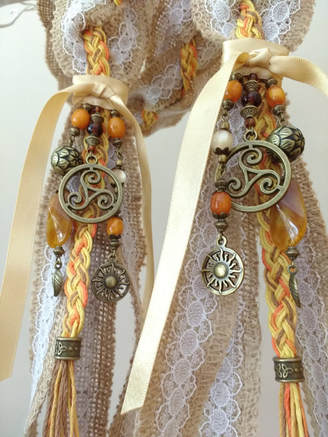 'Sun Spirit' handfasting cord
by Fable & Drifter
'Sun Spirit' handfasting cord
by Fable & Drifter
Fable & Drifter's range of handfasting cords is inspired by rustic, Celtic and medieval folk styles, and is based around natural materials and the use of colour derived from eco friendly dyes.
As an environmentally conscious maker it's important to me that most of the items in my range are made largely, or entirely from natural fibres such as hemp, hessian / burlap, jute and cotton.
My range of handfasting cords has been designed for couples who care for the environment and their impact on the world, and who wish to express their love and respect for nature and the Earth within their ceremony.
These cords appeal to couples wishing to connect with tradition, nature and spirit, those seeking a more environmentally friendly handfasting cord, and those who simply prefer something a bit different from glossy, contemporary styles. They work beautifully in mainstream and traditional weddings, and are ideal for woodland, countryside, rustic, vintage and eco wedding themes or for pagan, Wiccan or alternative handfasting ceremonies.
You can view a selection of my handfasting cords on the Gallery page of this website, and my current range is available to view and buy in the Fable & Drifter Etsy shop at: www.fableanddrifter.etsy.com.
I take time and care over every wedding cord, weaving all the braids by hand with positive energy and blessings. I always remain mindful that I'm making a deeply meaningful and personal item, and that it will form an important element of your special day and your future together. I pay careful attention to details and I do all I can to ensure the finished cord meets the customers' requirements.
Please see my Etsy shop reviews and the Testimonials page of this website for confirmation of the care I take in my work, the quality of my products and the personal attention I provide to customers.
As an environmentally conscious maker it's important to me that most of the items in my range are made largely, or entirely from natural fibres such as hemp, hessian / burlap, jute and cotton.
My range of handfasting cords has been designed for couples who care for the environment and their impact on the world, and who wish to express their love and respect for nature and the Earth within their ceremony.
These cords appeal to couples wishing to connect with tradition, nature and spirit, those seeking a more environmentally friendly handfasting cord, and those who simply prefer something a bit different from glossy, contemporary styles. They work beautifully in mainstream and traditional weddings, and are ideal for woodland, countryside, rustic, vintage and eco wedding themes or for pagan, Wiccan or alternative handfasting ceremonies.
You can view a selection of my handfasting cords on the Gallery page of this website, and my current range is available to view and buy in the Fable & Drifter Etsy shop at: www.fableanddrifter.etsy.com.
I take time and care over every wedding cord, weaving all the braids by hand with positive energy and blessings. I always remain mindful that I'm making a deeply meaningful and personal item, and that it will form an important element of your special day and your future together. I pay careful attention to details and I do all I can to ensure the finished cord meets the customers' requirements.
Please see my Etsy shop reviews and the Testimonials page of this website for confirmation of the care I take in my work, the quality of my products and the personal attention I provide to customers.
